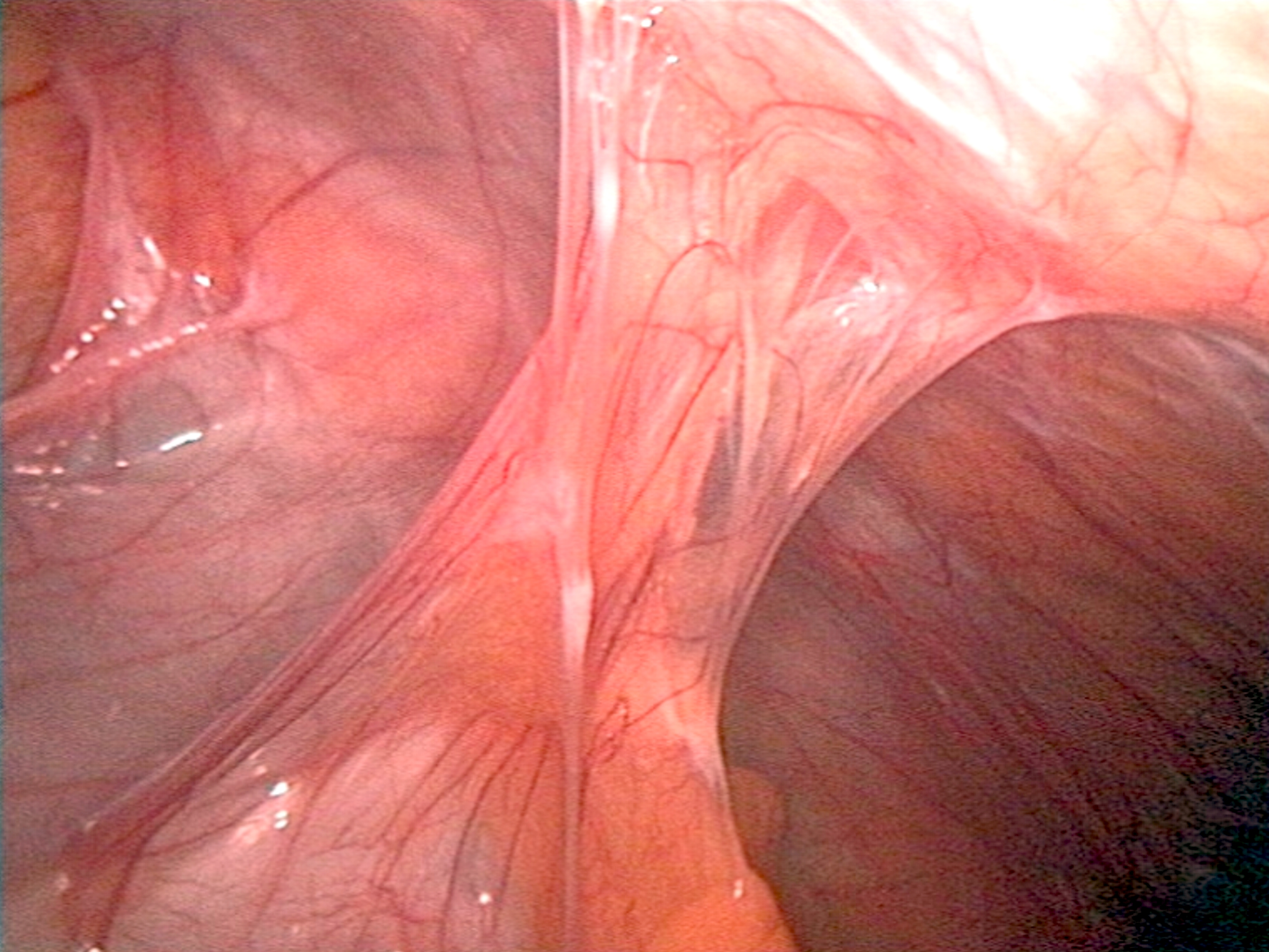
Adhesion (medicine)
Adhesions are fibrous bands that form between tissues and organs,[1] often as a result of injury during surgery. They may be thought of as internal scar tissue that connects tissues not normally connected.
Pathophysiology[edit]
Adhesions form as a natural part of the body's healing process after surgery in a similar way that a scar forms. The term "adhesion" is applied when the scar extends from within one tissue across to another, usually across a virtual space such as the peritoneal cavity. Adhesion formation post-surgery typically occurs when two injured surfaces are close to one another. According to the "classical paradigm" of adhesion formation, the pathogenesis starts with inflammation and activation of the coagulation system which causes fibrin deposits onto the damaged tissues.[2] The fibrin then connects the two adjacent structures where damage of the tissues occurred. The fibrin acts like a glue to seal the injury and builds the fledgling adhesion, said at this point to be "fibrinous." In body cavities such as the peritoneal, pericardial, and synovial cavities, a family of fibrinolytic enzymes may act to limit the extent of the initial fibrinous adhesion, and may even dissolve it. In many cases, the production or activity of these enzymes are compromised because of inflammation following injury or infection, however, and the fibrinous adhesion persists. A more recent study suggested that the formation of "fibrinous" adhesions is preceded by the aggregation of cavity macrophages, that can act like extravascular platelets in the abdominal cavity.[3]
If this is allowed to happen, tissue repair cells such as macrophages, fibroblasts, and blood vessel cells penetrate into the fibrinous adhesion and lay down collagen and other matrix substances to form a permanent fibrous adhesion. In 2002, Giuseppe Martucciello's research group showed a possible role could be played by microscopic foreign bodies (FB) inadvertently contaminating the operative field during surgery.[4] These data suggested that two different stimuli are necessary for adhesion formation: a direct lesion of the mesothelial layers and a solid substrate foreign body (FB).
While some adhesions do not cause problems, others may prevent muscle, nerve and other tissues and organs from moving freely, sometimes causing organs to become twisted or pulled from their normal positions.
Regions affected[edit]
Adhesive capsulitis[edit]
In the case of adhesive capsulitis of the shoulder (also known as frozen shoulder), adhesions grow between the shoulder joint surfaces, restricting motion.
Abdominal adhesions[edit]
Abdominal adhesions (or intra-abdominal adhesions) are most commonly caused by abdominal surgical procedures. The adhesions start to form within hours of surgery and may cause internal organs to attach to the surgical site or to other organs in the abdominal cavity. Adhesion-related twisting and pulling of internal organs may result in complications such as abdominal pain or intestinal obstruction.
Small bowel obstruction (SBO) is a significant consequence of post-surgical adhesions. A SBO may be caused when an adhesion pulls or kinks the small intestine and prevents the flow of content through the digestive tract. Obstruction may occur 20 years or more after the initial surgical procedure, if a previously benign adhesion allows the small bowel to twist spontaneously around itself and obstruct. Without immediate medical attention, SBO is an emergent, possibly fatal, condition.
According to statistics provided by the National Hospital Discharge Survey approximately 2,000 people die every year in the US from obstruction due to adhesions.[5] Depending on the severity of the obstruction, a partial obstruction may relieve itself with conservative medical intervention. Many obstructive events require surgery, however, to loosen or dissolve the offending adhesion(s) or to resect the affected small intestine.
Pelvic adhesions[edit]
Pelvic adhesions are a form of abdominal adhesions in the pelvis. In women they typically affect reproductive organs and thus are of concern in reproduction or as a cause of chronic pelvic pain. Other than surgery, endometriosis and pelvic inflammatory disease are typical causes.
Surgery inside the uterine cavity (e.g., suction dilation and curettage, myomectomy, endometrial ablation) may result in Asherman's syndrome (also known as intrauterine adhesions, intra uterine synechiae), a cause of infertility.
The impairment of reproductive performance from adhesions may happen through many mechanisms, all of which usually stem from the distortion of the normal tubo-ovarian relationship. This distortion may prevent an ovum from traveling to the fimbriated end of the fallopian tube.[6]
A meta-analysis in 2012 came to the conclusion that there is only little evidence for the surgical principle that using less invasive techniques, introducing fewer foreign bodies, or causing less ischemia reduces the extent and severity of adhesions in pelvic surgery.[7]
Pericardial adhesions[edit]
Adhesions forming between the heart and the sternum after cardiac surgery place the heart at risk of catastrophic injury during re-entry for a subsequent procedure.
Peridural adhesions[edit]
Adhesions and scarring as epidural fibrosis may occur after spinal surgery that restricts the free movement of nerve roots, causing tethering and leading to pain.
Peritendinous adhesions[edit]
Adhesions and scarring occurring around tendons after hand surgery restrict the gliding of tendons in their sheaths and compromise digital mobility.